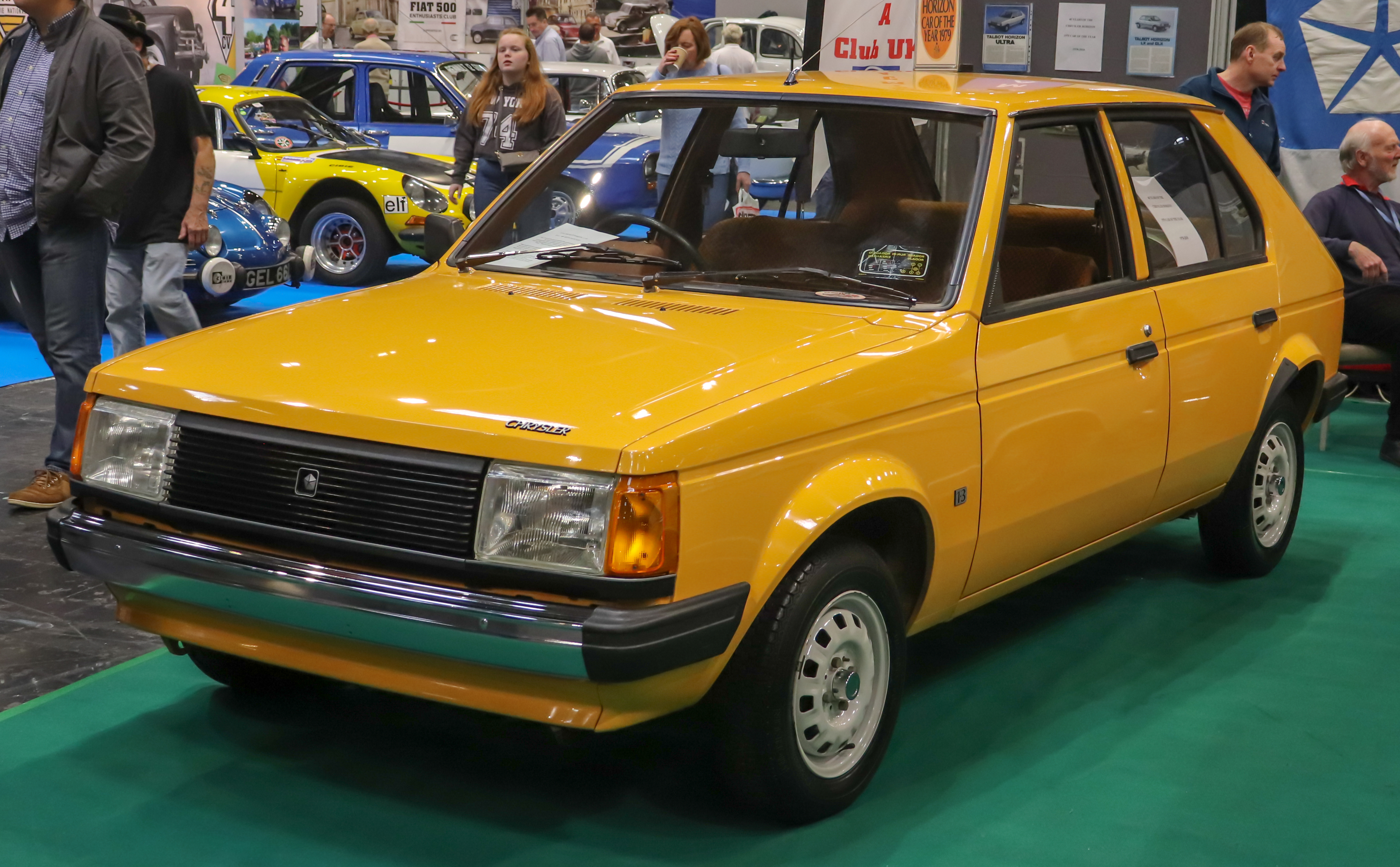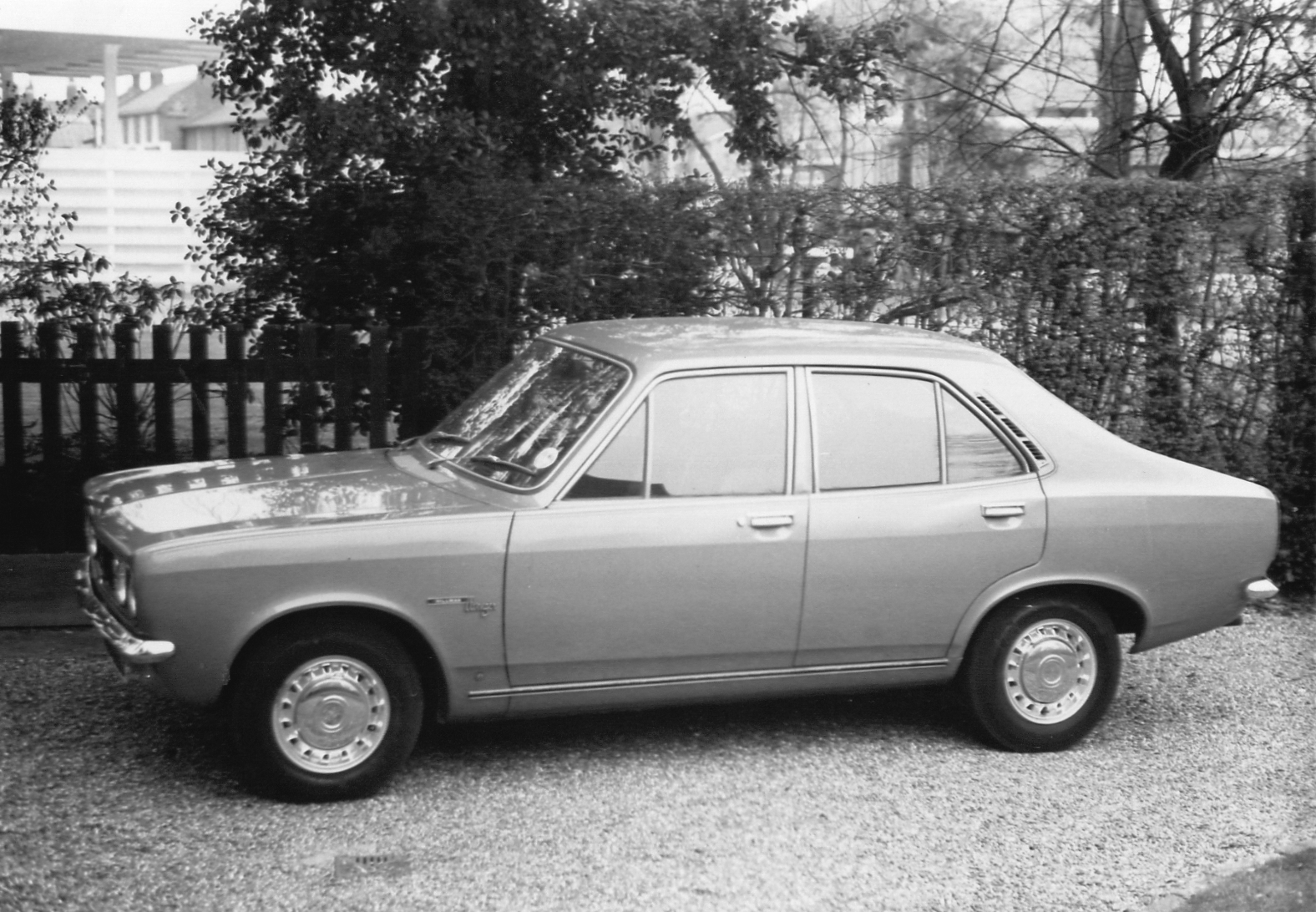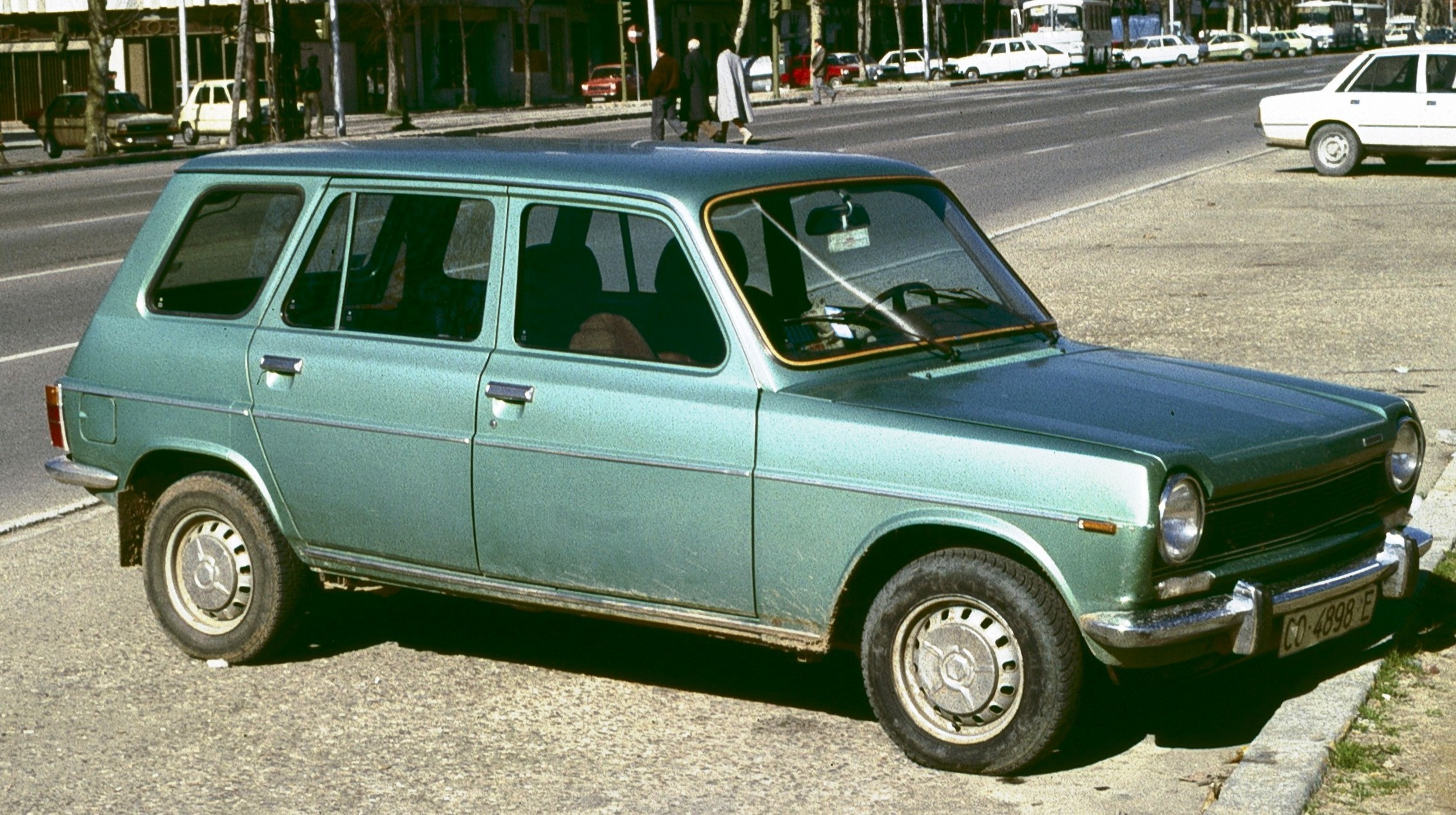|
Chrysler Horizon
The Chrysler Horizon is a compact hatchback that was designed by Chrysler Europe and was produced from 1978 to 1987 under the Chrysler, Simca and Talbot nameplates. The successor to both the Simca 1100 and Hillman Avenger, the Horizon adopted a front-wheel drive, transverse-engine layout. The model line was the first (and only) world car developed by Chrysler Corporation, who developed the American-market Dodge Omni/Plymouth Horizon in tandem, following the start of the Chrysler Europe project. While similar in appearance (for the Plymouth brand, sharing a nameplate), the Horizon would have substantial functional differences from its American counterpart. Following the 1978 sale of Chrysler Europe to Peugeot, the Horizon was rebranded under the revived Talbot marque from 1979 onward. Alongside assembly in Chrysler Europe (later Peugeot) facilities in France and the United Kingdom, the Horizon was assembled by Saab in Finland and by Peugeot-Talbot in Spain. Origins The ... [...More Info...] [...Related Items...] OR: [Wikipedia] [Google] [Baidu] |
Talbot (automobile)
Talbot was an automobile marque introduced in 1902 by English-French company Clément-Talbot. The founders, Charles Chetwynd-Talbot, 20th Earl of Shrewsbury and Adolphe Clément-Bayard, reduced their financial interests in their Clément-Talbot business during the First World War. Soon after the end of the war, Clément-Talbot was brought into a combine named STD Motors. Shortly afterward, STD Motors' French products were renamed Talbot instead of Darracq. In the mid-1930s, with the collapse of STD Motors, Rootes bought the London Talbot factory and Antonio Lago bought the Paris Talbot factory, Lago producing vehicles under the marques Talbot and Talbot-Lago. Rootes renamed Clément-Talbot Sunbeam-Talbot in 1938, and stopped using the brand name Talbot in the mid-1950s. The Paris factory closed a few years later. Ownership of the marque came by a series of takeovers to Peugeot, which revived use of the Talbot name from 1978 until 1994. [...More Info...] [...Related Items...] OR: [Wikipedia] [Google] [Baidu] |
Petrol Engine
A petrol engine (gasoline engine in American English) is an internal combustion engine designed to run on petrol (gasoline). Petrol engines can often be adapted to also run on fuels such as liquefied petroleum gas and ethanol blends (such as ''E10'' and ''E85''). Most petrol engines use spark ignition, unlike diesel engines which typically use compression ignition. Another key difference to diesel engines is that petrol engines typically have a lower compression ratio. Design Thermodynamic cycle Most petrol engines use either the four-stroke Otto cycle or the two-stroke cycle. Petrol engines have also been produced using the Miller cycle and Atkinson cycle. Layout Most petrol-powered piston engines are straight engines or V engines. However, flat engines, W engines and other layouts are sometimes used. Wankel engines are classified by the number of rotors used. Compression ratio Cooling Petrol engines are either air-cooled or water-cooled. Ignition Petrol e ... [...More Info...] [...Related Items...] OR: [Wikipedia] [Google] [Baidu] |
PSA Group
The PSA Group (), legally known as Peugeot S.A. (Peugeot Société Anonyme, trading as Groupe PSA; formerly known as PSA Peugeot Citroën from 1991 to 2016) was a French multinational automotive manufacturing company which produced automobiles and motorcycles under the Peugeot, Citroën, DS, Opel and Vauxhall brands. On 18 December 2019, PSA and Fiat Chrysler Automobiles (FCA) announced that they had agreed to the terms of a binding $50 billion merger. On 16 July 2020, both companies announced the new name for their merged operations, Stellantis. The deal closed on 16 January 2021. Stellantis is now the third largest automotive manufacturing company, behind only Volkswagen and Toyota. Peugeot was the largest PSA brand. PSA was listed on the Euronext Paris stock exchange and was a constituent of the CAC 40 index. Beginning in 2016, PSA began to outline a strategy which entailed the rapid expansion of the company, through both geographic expansion and acquisitions of other ... [...More Info...] [...Related Items...] OR: [Wikipedia] [Google] [Baidu] |
Peugeot
Peugeot (, , ) is a French brand of automobiles owned by Stellantis. The family business that preceded the current Peugeot companies was founded in 1810, with a steel foundry that soon started making hand tools and kitchen equipment, and then bicycles. On 20 November 1858, Émile Peugeot applied for the lion trademark. Armand Peugeot (1849–1915) built the company's first car steam tricycle, in collaboration with Léon Serpollet in 1889; this was followed in 1890 by an internal combustion car with a Panhard- Daimler engine. The Peugeot company and family are originally from Sochaux. Peugeot retains a large manufacturing plant and Peugeot museum there. In February 2014, the shareholders agreed to a recapitalisation plan for the PSA Group, in which Dongfeng Motors and the French government each bought a 14% stake in the company. Peugeot has received many international awards for its vehicles, including six European Car of the Year awards. Peugeot has been involved suc ... [...More Info...] [...Related Items...] OR: [Wikipedia] [Google] [Baidu] |
World Car
The phrase world car is an engineering strategy used to describe an automobile designed to suit the needs of global automotive markets with minimal changes in each market where it is sold. The goal of a world car program is to save costs and increase quality by standardizing parts and design for a single vehicle in a certain class, in hopes of using the cost savings to deliver a superior product that satisfies expectations for quality, appeal and performance of automobile buyers worldwide. Examples include the Ford Mondeo and Focus, modern no-frills cars such as the Fiat Palio, Dacia Logan and VW Fox along with luxury cars such as the BMW 3 Series and Lexus LS. History of the world car In the pioneering days of the automotive industry, automobiles were primarily designed for the local market that the manufacturer was based in, such as the Ford Model T, which was engineered to cope with the rural lifestyle and rugged terrain that most automobile buyers in the United States had to cont ... [...More Info...] [...Related Items...] OR: [Wikipedia] [Google] [Baidu] |
Simca
Simca (; Mechanical and Automotive Body Manufacturing Company) was a French automaker, founded in November 1934 by Fiat S.p.A. and directed from July 1935 to May 1963 by Italian Henri Pigozzi. Simca was affiliated with Fiat and, after Simca bought Ford's French subsidiary, became increasingly controlled by Chrysler. In 1970, Simca became a brand of the Chrysler's European business, ending its period as an independent company. Simca disappeared in 1978, when Chrysler divested its European operations to another French automaker, PSA Peugeot Citroën. PSA replaced the Simca brand with Talbot after a short period when some models were badged as Simca-Talbots. During most of its post-war activity, Simca was one of the biggest automobile manufacturers in France. The Simca 1100 was for some time the best-selling car in France, while the Simca 1307 and Simca Horizon won the coveted European Car of the Year title in 1976 and 1979, respectively—these models were badge engineered as prod ... [...More Info...] [...Related Items...] OR: [Wikipedia] [Google] [Baidu] |
Chrysler Europe
Chrysler Europe was the American automotive company Chrysler's operations in Europe from 1967 through 1978. It was formed from the merger of the French Simca, British Rootes and Spanish Barreiros companies. In 1978, Chrysler divested these operations to PSA Peugeot Citroën. PSA rebadged the former Chrysler and Simca models with the revived Talbot marque, but abandoned the brand for passenger cars in 1987, although it continued on commercial vehicles until 1994. Among the remaining Chrysler Europe assets still in existence are the former Simca factory in Poissy, the former Barreiros plant in the Madrid suburb Villaverde, which both serve as major Peugeot-Citroën assembly plants, and the Rootes Group research and development complex in Whitley, Coventry, which is now the headquarters of Jaguar Land Rover. History Formation Chrysler Corporation had never had much success outside North America, contrasting with Ford's worldwide reach and General Motors' success with O ... [...More Info...] [...Related Items...] OR: [Wikipedia] [Google] [Baidu] |
Dodge Omni
The Dodge Omni (and the nearly identical Plymouth Horizon) is a subcompact car that was produced by Chrysler Corporation from the 1978 to 1990 model years. The first Chrysler model line produced with front-wheel drive, the Omni and Horizon were also the first front-wheel drive economy cars assembled in the United States. Marketed for eleven years with very few changes, around 2,500,000 Omnis and Horizons were built with the Plymouth badged versions more popular than the Dodge branded models. The first (and only) world car designed by Chrysler, the model line originated from a design of Chrysler Europe (who developed the namesake Chrysler Horizon). While visually similar, the American Omni/Horizon would have extensive functional differences from its European counterpart. From 1977 to 1990, Chrysler produced the Omni and Horizon at its Belvidere Assembly Plant facility (Belvidere, Illinois); from 1987 to 1989, the model line was license-built by American Motors Corporation (AMC) ... [...More Info...] [...Related Items...] OR: [Wikipedia] [Google] [Baidu] |
Peugeot 309
The Peugeot 309 is a small family car that was manufactured between 1985 and 1994 in England, Spain and France by PSA Peugeot Citroën. It was originally intended to be badged as a Talbot and, as development progressed, to be called the Talbot Arizona. It was the replacement for the Talbot Horizon, which had started life as a Chrysler in Britain and a Simca in France, and was also being built in several guises for the market in America. In 1985, the PSA Group decided to discontinue the Talbot brand, with the last passenger vehicle branded as a Talbot to be launched being the Samba of 1981, and to market the car as a Peugeot instead. The Talbot brand was phased out completely when Talbot Express production stopped in 1994. History The 309 had been conceived as ''Projet C28'' as a replacement for the Talbot Horizon, and as a result its development had been performed by the former Chrysler/Simca wing of PSA. Styling was the responsibility of the former Chrysler-Rootes design st ... [...More Info...] [...Related Items...] OR: [Wikipedia] [Google] [Baidu] |
Hillman Avenger
The Hillman Avenger is a rear-wheel drive small family car originally manufactured by the former Rootes division of Chrysler Europe from 1970–1978, badged from 1976 onward as the Chrysler Avenger. Between 1979 and 1981 it was manufactured by PSA Peugeot Citroën and badged as the Talbot Avenger. The Avenger was marketed in North America as the Plymouth Cricket and was the first Plymouth to have a four-cylinder engine since the 1932 Plymouth Model PB was discontinued. The Avenger was initially produced at Rootes' plant in Ryton-on-Dunsmore, England, and later at the company's Linwood facility near Glasgow, Scotland. 1970: Hillman Avenger Introduced in February 1970, the Avenger was significant as it was the first and last car to be developed by Rootes after the Chrysler takeover in 1967. Stylistically, the Avenger was undoubtedly very much in tune with its time; the American-influenced "Coke Bottle" waistline and semi-fastback rear-end being a contemporary styling cue, indeed ... [...More Info...] [...Related Items...] OR: [Wikipedia] [Google] [Baidu] |
Simca 1100
The Simca 1100 is a car built from 1967 to 1982 by Simca. It was replaced by the Simca-Talbot Horizon. History The 1100 was the result of "Project 928", started in 1962, finalized by engineers Philippe Grundeler and Charles Scales. The design was a result of Simca's market research in the early 1960s, which showed the increasing popularity of front wheel drive cars that provided better utilization of space and comfort in small cars. In Spring 1962, Simca organized a 1966–67 launch of a new range of front wheel drive cars with saloons, estates cars and light commercial vehicles to be included, all fitting into France's 6CV tax class – between the Simca Mille and Simca 1300. Both transverse and longitudinal engine placement were tested, and in 1963 the transverse-engine design was approved. The Simca 1100 was one of the first designs outside Fiat to feature a transverse engine with an end-on gearbox and unequal length driveshafts (now near-universal amongst small cars), a possibl ... [...More Info...] [...Related Items...] OR: [Wikipedia] [Google] [Baidu] |
PSA XUD
The PSA XUD is a diesel engine designed and built by PSA - Peugeot and Citroën. It is an Indirect injection (IDI) engine, that uses a version of the Ricardo Consulting Engineers ''Ricardo Comet V'' prechamber cylinder head design. The engine comes in , , and 2.1-liter displacements. The 2.1 has 12 valves, all displacements were built either naturally aspirated or turbocharged. The XUD was the predecessor to the HDI range of engines. Early HDi Engines were a PSA design, later 16-valve engines were jointly developed with Ford. Design The XUD was available with either SOHC 8-valve or 12-valve heads. It was mainly applied transversally in front wheel drive vehicles, tilted by 30°. However, some applications in non-PSA vehicles had the engine installed longitudinally, with rear-wheel drive. The XUD is built in Citroën's plant in Trémery, near Metz. Displacement ranges between , and all XU diesel engines have a stroke of either . The former was shared with the XU9. Bore sizes ... [...More Info...] [...Related Items...] OR: [Wikipedia] [Google] [Baidu] |





.jpg)


